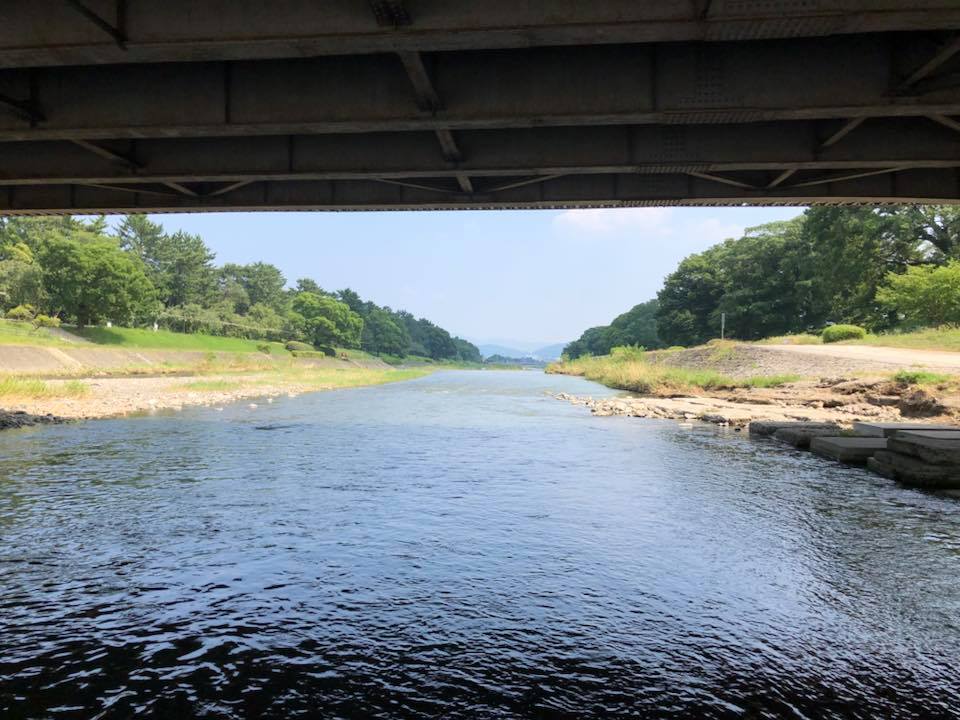
Walking on Water with Jesus
I can’t remember where the initial idea came from, but I do know that it was three years old. I thought it would be interesting to walk the Kamogawa in Kyoto. By that I mean literally walk the river, straight down the middle of its bed. During the drier days of August, the water looks to be only about shin deep, and would be a refreshing distraction from the heat. And as a companion, it could only be Chris Irwin, who with his hair wild and beard tidy, bears a passing resemblance to Eric Idle’s Jesus. He seemed the perfect co-conspirator in foolish ideas.
I wanted to walk on an incredibly hot day, when the rain hadn’t fallen for a week or more. The more sensible of Kyoto’s foreign expats tend to avoid the heat of August by going abroad, and Chris and I were no exception, which narrowed our window of opportunity to just a week or two each year. Dates would be chosen, and without fail, it would rain heavily the night before. But both of us were in town for much of this summer, one whose weather was taking on the disaster-like proportions of another Irwin, Irwin Allen. And the day finally came.
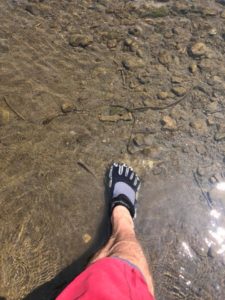
Japan was currently suffering under a murderous heat wave, and on the day we chose, Kyoto set the national high of 39.8℃. In the spirit of pilgrimage, the section of river between the Kamigamo and Shimogamo shrines seemed a good choice, and the bike ride up to the northern part of the city encased the body in a sweat that would be a delight to rinse off.
We bowed to the deities, under the watchful guise of a shrine worker who I assume carries a protractor to aid the pagan foreign tourist in showing the proper degree of respect. The next angling was down the adjacent riverbank and onto the stony banks beneath the bridge leading to the shrine. Those initial few steps quickly brought with them a welcome respite from the heat.
For a while the river was shallow, well below knee-height. One facet I hadn’t thought too much about was the concrete waterfalls that help control the flow. They are placed at intervals of about two or three hundred meters, and though only a meter or so in height, you could never be sure of the depth at the far side. For the first couple, we found breaks in the stone work from the recent floods, where the water poured through like a waterslide. But we grew more confident as we went, looking down for a moment or so for a rock to step down onto, and then a second step that was a leap of faith into churning white water.
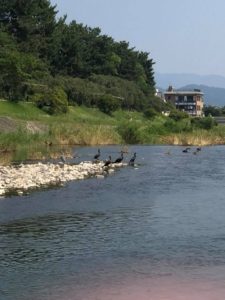
We had companions along the way: blue herons, white egrets, and black cormorants. Mandarin ducks floated at the edge of the waterfalls, eyeing an ease of entry in a way similar to what we’d been doing. A suppon turtle showed itself against the muddy bottom, moving quickly away when it felt the falling over of our shadows. Turtles move pretty quickly in the water, and it when it turned toward us again, we made certain to stay clear of the suppon’s sharp teeth. One thing we didn’t see were the nutria that once hunted the banks down near Demachiyanagi. An invasion species sure, but it was always interesting to see their furry shapes dart from the reeds to the water and back. Sadly the city of Kyoto seems to have deported them once and for all.
It was a joyful walk, Chris and I catching up after a long separation, our tales of recent events broken now and again by film quotes, fragments of song lyrics, or simply comments of overall silliness. We tried to bring some of the locals into the fun, as many on the banks looked incredulously at our undertaking. We waved to absolutely everyone. One old fellow trailed us with his expensive camera, snapping more furiously than the suppon earlier.
As we went along, the water took on a varying degree of depth. While it looked a uniform level from the bicycle path on the river bank, it varied quite dramatically. The fast moving water betrayed the shallows, but the narrow channels were of surprising depth. In a couple of spots we were up to our chests, forcing us to raise our bags and mobile phones over our heads. It was here that Chris broke into his Kate Hepburn imitation: “Is that a leech, Mr. Allnut?”
I imagine that the week of raging waters earlier in July had scoured the riverbed clean of debris and dangerous objects. It was much more stone laden than expected, and every so often I’d lurch to one side as an unseen rock would turn underfoot. I’d opted at the last minute for an old pair of Vibram Five Fingers for this particular mission, and by the time we were at Kuramaguchi Bridge both soles had peeled back like bananas. They separated completely not long afterward, so I stuck them into my pockets and continued along.
Beyond the concrete fish ladders above Demachiyanagi, the water took on a somewhat foul smell, and bits of debris appeared: a tire upon a broken axle; a long section of bamboo fence. I was moving slowly now, every step agony, like the most painful reflexology session in the world. Finally, hand in hand, Chris and I stepped up the actually confluence of the Kamogawa and Takasegawa, as around us college-age students splashed and frolicked and giggled. Only the gods now awaited, as my gait once again returned to its usual stride, and the soft, groomed sand of Shimogamo’s forested approach led us to our final ablutions of thanks.
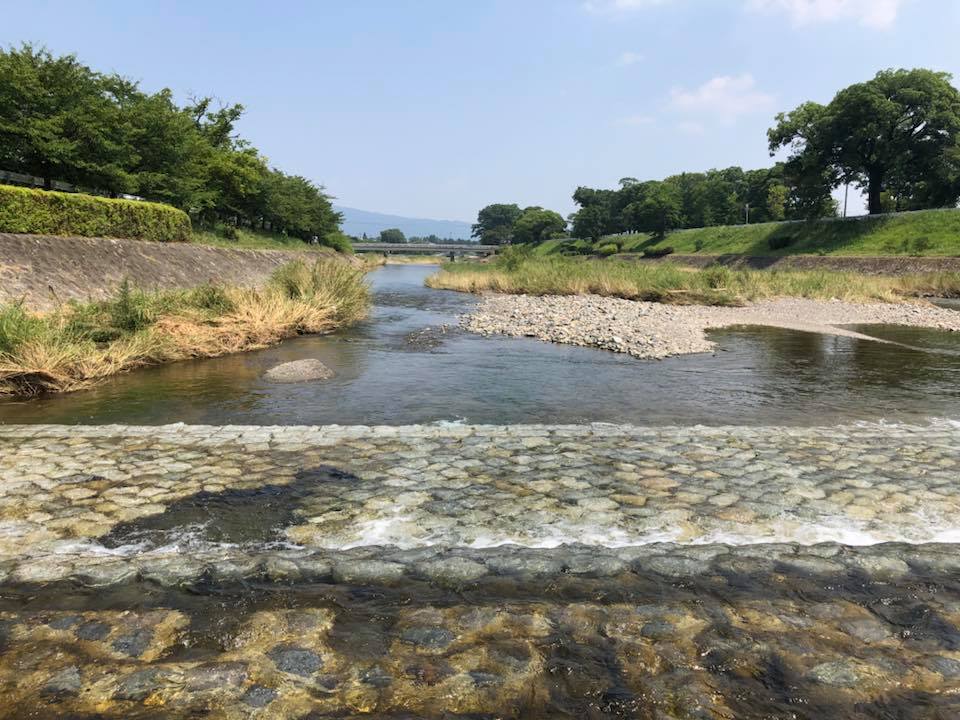
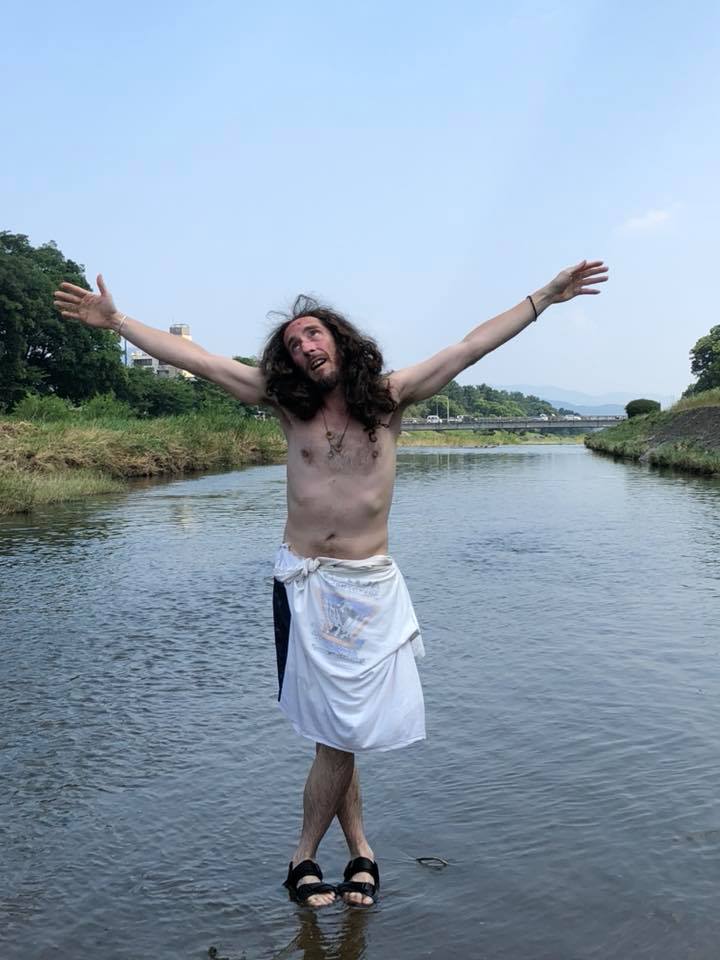
For other pieces by Edward J Taylor, see this piece or this one.
